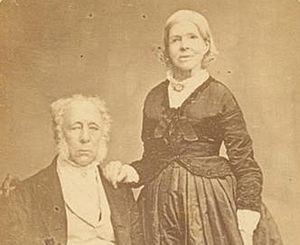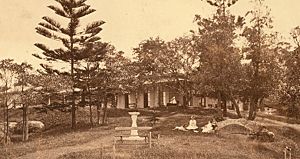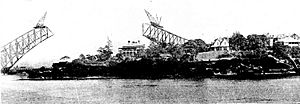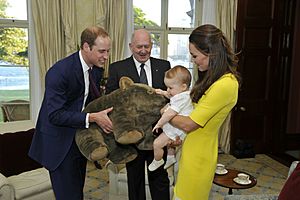Admiralty House, Sydney facts for kids
Quick facts for kids Admiralty House |
|
|---|---|
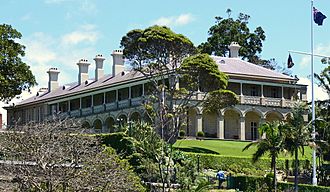
Admiralty House viewed from the south
|
|
| Former names | Wotonga |
| General information | |
| Status | Complete |
| Type | Viceregal residence of the Governor-General |
| Architectural style |
|
| Location | 109 Kirribilli Avenue, Kirribilli, Sydney, New South Wales |
| Country | Australia |
| Coordinates | 33°51′06″S 151°13′06″E / 33.851735°S 151.218245°E |
| Construction started | 1842 |
| Completed | 1843 |
| Client | John George Nathaniel Gibbes |
| Owner | Queen Elizabeth II in Right of The Commonwealth of Australia |
| Technical details | |
| Material | Sydney sandstone |
| Design and construction | |
| Architect |
|
| Architecture firm | Colonial Architect |
| Official name | Admiralty House Garden and Fortifications |
| Type | Built |
| Designated | 22 June 2004 |
| Reference no. | 105399 |
Admiralty House is a special home in Sydney. It's where the Governor-General, Australia's head of state representative, lives when they are in Sydney. It's in Kirribilli, right on the northern side of Sydney Harbour. It's even next door to Kirribilli House, which is where the Prime Minister stays in Sydney.
This large house is made of Sydney sandstone. It was built in different stages, following designs by James Barnet and Walter Liberty Vernon. The building combines two styles: Victorian Regency and Italianate. It sits at the very tip of Kirribilli Point.
The house was once called "Wotonga". It has amazing views across Sydney Harbour, including the Sydney Harbour Bridge and the Sydney Opera House. Its current name, Admiralty House, comes from its time as the home for the Commander-in-Chief of the Royal Navy's Australia Squadron from 1885 to 1913.
The first building on this spot was finished in 1843. It was a private home for John George Nathaniel Gibbes. He was the Collector of Customs for New South Wales. A painting of Gibbes from 1808 still hangs in the house today. On June 22, 2004, Admiralty House was added to the Commonwealth Heritage List. This list protects important places in Australia.
Contents
History of Admiralty House
Early Days in Kirribilli
Before British settlers arrived, the Aboriginal Cammeraygal people lived around Kirribilli. They fished along the foreshores of Kirribilli and Milsons Point. The name Kirribilli comes from the Aboriginal word kiarabilli, meaning "good fishing spot".
Kirribilli was one of the first areas settled in the colony. In 1794, a former convict named Samuel Lightfoot received a land grant here. Later, Thomas Muir, a Scottish reformer, bought this farm. He named it "Huntershill". Muir escaped the colony in 1796.
By 1801, the land belonged to Robert Campbell, a rich Sydney merchant. Campbell built Australia's first shipbuilding yards in 1807. This area is now home to the Royal Sydney Yacht Squadron. Part of the land was even used as a quarantine area in 1814 for a ship with sick convicts.
Campbell leased some of his land to James Milson. This is why the nearby area is called "Milson's Point". In the 1840s, Campbell divided his land into smaller blocks. In 1842, a 5-acre block was leased to Colonel Gibbes. He wanted to build a private home there.
A Private Home Called Wotonga
Between 1842 and 1843, Gibbes built a lovely single-storey house. It had wide verandahs and French doors. Gibbes designed the house himself and called it "Wotonga". The stone for the walls came from local quarries. The wood for the inside came from a timber-yard in Sydney.
Gibbes hired a builder named James Hume to oversee the work. But Gibbes also hired his own workers, paying them directly. He even used his Customs Department boat to travel to the building site. Once finished, Wotonga had a stylish design to make the most of its amazing views. From his home, Gibbes could watch ships entering and leaving Sydney Harbour.
Today, Wotonga is the main part of Admiralty House. The views are even more impressive now with Sydney's tall buildings.
In 1849, Robert Campbell died. Gibbes bought the house and land for about £1,400. In 1851, Gibbes sold the property to James Lindsay Travers for £1,533. Later, in 1854, a small part of the land was sold to Adolph Frederic Feez. On this land, Kirribilli House was built. Kirribilli House is now the official Sydney home for the Prime Minister.
Later Owners
In 1856, Lieutenant-Colonel Barney bought the house. He wanted to see all the forts he had built. In 1860, he sold it to George Alfred Lloyd. Later, it was rented by Frederick Lassetter and then by James Robert Wilshire. Wilshire was a former Lord Mayor of Sydney.
In 1874, Wotonga House was sold at auction to Thomas Cadell for £10,100. Cadell was a Sydney merchant. At that time, the house was described as having many rooms, including 10 bedrooms. It also had a large courtyard and stables.
Becoming Admiralty House
In 1885, the Royal Navy's Australian Squadron became more important. The colonial government bought "Wotonga" to be the home for the Admiral of the Navy. The house was then renamed "Admiralty House". More parts were added to the building. A second floor was built, along with a new verandah with columns. A gatehouse was also added at the entrance. There was even a special covered path for the Admiral to walk down to his boat.
In 1913, the last British admiral left the house. The Royal Australian Navy took over Australia's naval defence.
From 1901, the Governor-General used Government House in Farm Cove as their Sydney home. But in 1912, the New South Wales Government decided to use that building for other public purposes. This left the Governor-General, Lord Denman, without a Sydney residence.
Home for Governors-General
When the last British Admiral left Admiralty House in 1913, the house was given back to the New South Wales Government. This meant it could become the Sydney home for the new Governor-General, Sir Ronald Munro Ferguson. Admiralty House was the Governor-General's residence for the next fifteen years.
In 1930, during the Great Depression, the government closed Admiralty House. Its furniture was sold in 1931. The Governor-General at the time, Sir Isaac Isaacs, was the first to live full-time at Yarralumla in Canberra. Admiralty House stayed empty and neglected. Sir Isaac said in 1934 it was "stripped of its glamour" and its garden was "wild and overgrown".
In 1936, the State of New South Wales reopened Admiralty House. It became the Sydney home for the new Governor-General, Lord Gowrie. Since then, it has always been used as a special home for the Governor-General. In 1948, the ownership of Admiralty House officially moved from the State Government to the Australian Government. The condition was that it must only be used as the Governor-General's residence.
What is Admiralty House Used For?
Admiralty House is one of the official homes for the Governor-General of Australia. It's also where important visitors from other countries stay when they visit Sydney. Members of the Royal Family and other important people, like the President of the United States or the Pope, are hosted here.
Admiralty House, its gardens, and Kirribilli House are usually open to the public once a year. This often happens in spring when the gardens look their best.
Architecture and Design
Inside the House
The ground floor of Admiralty House has a main entrance area and a hallway. There are two reception rooms, a dining room, and a study. A grand staircase leads to the upper floors. The private rooms for the residents are on these upper levels. The staircase landing has beautiful stained glass windows. The kitchens and other service areas are in a part of the building added later. A stone gatehouse stands at the front entrance.
The house is filled with old furniture, beautiful porcelain, and many historical artworks. These include paintings of Captain James Cook and some past Governors-General. Many of these items were bought for the nation by The Australiana Fund.
See also
 In Spanish: Casa del Almirantazgo para niños
In Spanish: Casa del Almirantazgo para niños


